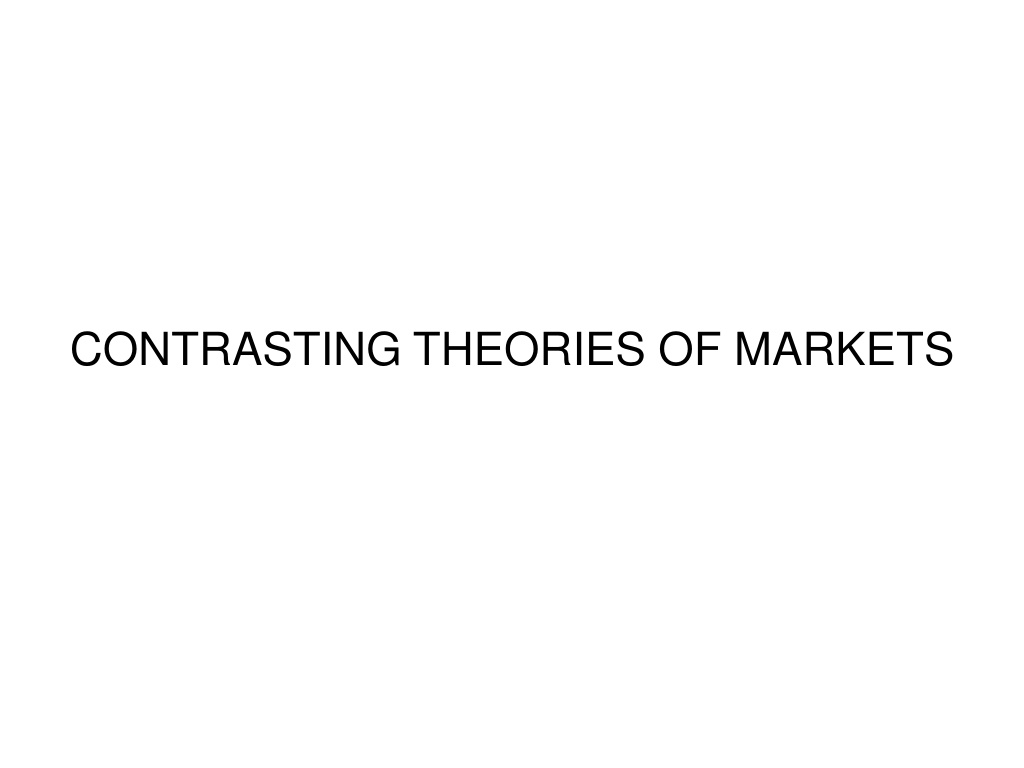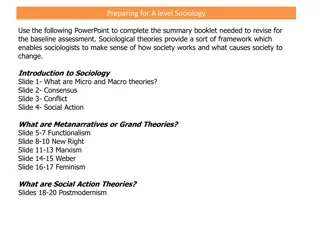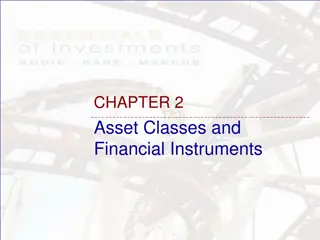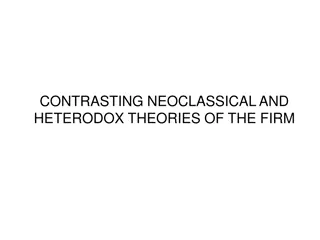CONTRASTING THEORIES OF MARKETS
The contrasting theories of markets by Friedrich von Hayek and John Kenneth Galbraith highlight the impact of changes in the availability of raw materials on economic systems. Hayek emphasizes the decentralized information flow and market mechanisms, while Galbraith discusses the role of corporations in planning and control. Additionally, Joseph Schumpeter's insights shed light on the evolving nature of competition in capitalist economies, emphasizing factors beyond price competition. The data on changes from 1990 to 2000 in robotics technology showcases significant advancements in various aspects such as unit price, delivery numbers, product variants, handling capacity, accuracy, speed, and technological performance metrics. These perspectives offer valuable insights into market dynamics, economic planning, technological advancements, and competition in modern economies.
Download Presentation

Please find below an Image/Link to download the presentation.
The content on the website is provided AS IS for your information and personal use only. It may not be sold, licensed, or shared on other websites without obtaining consent from the author.If you encounter any issues during the download, it is possible that the publisher has removed the file from their server.
You are allowed to download the files provided on this website for personal or commercial use, subject to the condition that they are used lawfully. All files are the property of their respective owners.
The content on the website is provided AS IS for your information and personal use only. It may not be sold, licensed, or shared on other websites without obtaining consent from the author.
E N D
Presentation Transcript
Assume that somewhere in the world a new opportunity for the use of some raw material, say tin, has arisen, or that one of the sources of supply of tin has been eliminated. It does not matter for our purpose and it is very significant that it does not matter which of these two causes has made tin more scarce. All that the users of tin need to know is that some of the tin they used to consume is now more profitably employed elsewhere, and that in consequence they must economize tin. ... the effect will rapidly spread throughout the whole economic system and influence not only all the uses of tin, but also those of its substitutes and the substitutes of these substitutes, the supply of all things made of tin, and their substitutes, and so on; and all this without the great majority of those instrumental in bringing about these substitutions knowing anything at all about the original cause of these changes. The whole acts as one market, not because any of its members survey the whole field, but because their limited individual fields of vision sufficiently overlap so that through many intermediaries the relevant information is communicated to all. Friedrich von Hayek, The Use of Knowledge in Society
[A corporation] must exercise control over what is sold. It must exercise control over what is supplied. It must replace the market with planning. John Kenneth Galbraith, The New Industrial State Long-range investing under rapidly changing conditions, especially under conditions that change or may change at any moment under the impact of new commodities and technologies, is like shooting at a target that is not only indistinct but moving and moving jerkily at that. Joseph Schumpeter, Capitalism, Socialism and Democracy
Economists are at long last emerging from the stage in which price competition was all they say. As soon as quality competition and sales effort are admitted ... the price variable is ousted from its dominant position. ... in capitalist reality as distinguished from its textbook picture, it is not ... [price] competition which counts but the competition from the new commodity, the new technology, the new source of supply, the new type of organization (the largest- scale unit of control for instance) competition which commands a decisive cost or quality advantage and which strikes not at the margins of the profits and the outputs of the existing firms but at their foundations and their very lives. This kind of competition is as much more effective than the other as a bombardement is in comparison with forcing a door Joseph Schumpeter, Capitalism, Socialism and Democracy
CHANGES FROM 1990 TO 2000 -43% List price of one robot unit 782% Number of units delivered 400% Number of product variants that can be supplied to customers 26% Total handling capacity (including gripper module) 61% Repetition accuracy 39% Speed of the 6 axes 36% Maximum reach 137% Mean-time between failures over 400 times RAM in Mbytes 117% Bit-size of the processor 45% Maximum number of axes that can be controlled
R&D Investment 30,000.00 4. Sales up to 50,000,000 (419) 25,000.00 1,491.30 R&D Investment (in ) 3,734.14 3. Sales from 50,000,000 to 500,000,000 (340) 2. Sales from 500,000,000 to 5,000,000,000 (187) 1. Sales over 5,000,000,000 (54) 20,000.00 6,281.63 15,000.00 10,000.00 13,754.58 5,000.00 0.00
R&D Investment 60.0% 50.0% 40.0% 30.0% 20.0% 10.0% 0.0% 5 24 25-49 50-99 100-249 250-499 500-999 1,000-4,999 5,000-9,999 25,000 and more 10,000-25,000 % of firms % of investment
R&D Investment (1000 biggest firms, world) 3. Sales from 50,000,000 to 500,000,000 (129) 2. Sales from 500,000,000 to 5,000,000,000 (491) 1. Sales over 5,000,000,000 (380) 100% 8,839.51 65,779.10 80% 60% 40% 269,398.13 20% 0%

























